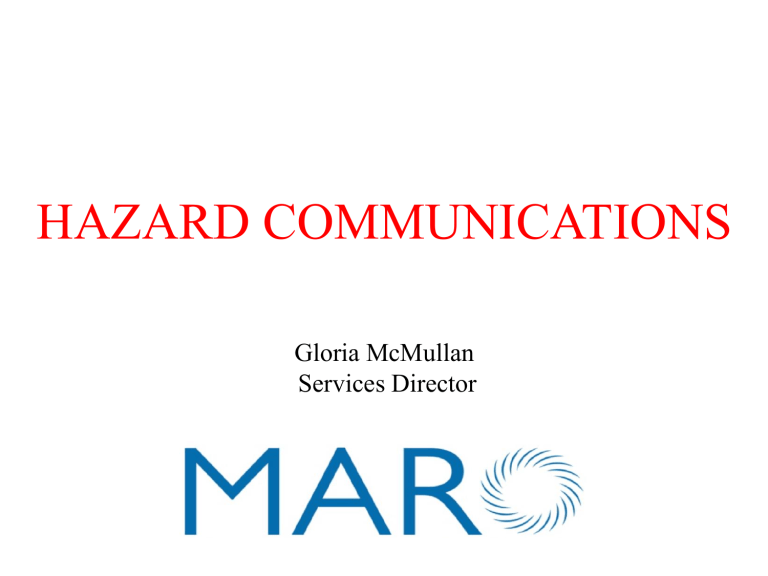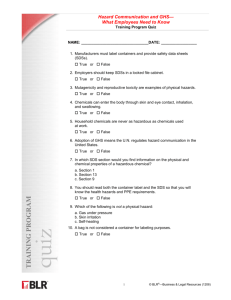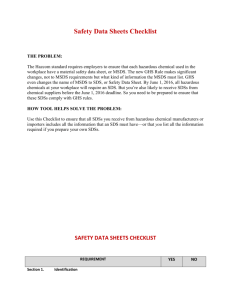
HAZARD COMMUNICATIONS Gloria McMullan Services Director This material was prepared under a Consultation Education and Training (CET) Grant awarded by the Michigan Occupational Safety and Health Administration (MIOSHA). MIOSHA is part of the Michigan Department of Licensing & Regulatory Affairs (LARA). Points of view or opinions stated in this document do not necessarily reflect the view or policies of LARA. 2 Hazard Communication TRAINING OBJECTIVES • Why this standard took effect • Discussion of The Right-to-Know Law • GHS -New Workplace Specifics • Review of Label Requirements / SDS • Question & Answer 3 Right to Know • Under the standard, – Employers must identify and evaluate chemical hazards in the workplace – Written Hazard Communications Plan: Communicate information concerning those hazards to employees. – Requires employers to make sure that employees receive this information by implementing a comprehensive hazard communication program. • container labeling • Safety Data Sheets (SDSs) • employee training. 4 Revised Posters – MSDS to SDS Safety Data Sheets: Your Rights: • Required from the manufacturer or distributor of any hazardous material. • Contains sections of information about the hazardous material. • Your employer must have an MSDS for every hazardous substance you use as part of your job. • These MSDS’s must be available to you the entire time you are in the workplace. 6 Labels There are several new label elements: •Symbols called “Pictograms” •Signal Words •Hazard Statements •Precautionary Statements •Product Identification •Supplier/Manufactur er Identification www.osha.gov/Publications/HazComm_QuickCard_Labels.html Safety Data Sheets (SDSs) New 16-section standardized SDS format required (ANSI Z400.1) Section 1 – Identification Section 2 – Hazard(s) identification Section 10 – Stability and Reactivity Section 11 – Toxicological Information Section 3 – Composition / Information on Ingredients Section 12 – Ecological Information* Section 4 – First-aid Measures Section 5 – Fire-fighting Measures Section 6 – Accidental Release Measures Section 7 – Handling and Storage Section 8 – Exposure Controls / Personal Protection Section 9 – Physical and Chemical Properties Section 13 – Disposal Consideration* Section 14 – Transport Information* Section 15 – Regulatory Information* Section 16 – Other information including date of preparation of last revision *Sections outside of MIOSHA jurisdiction but inclusion of these sections is necessary for a GHS compliant SDS Labels: Signal Word These are words used to indicate the severity of the hazard and alert employees to the potential hazard. Only 2 signal words will appear: – “DANGER”(more severe hazard) – “WARNING” (less severe hazard) Not all labels will have a signal word. Some chemicals are not hazardous enough to require that a signal word appear on the label. Safety Data Sheets (continued) Section 1 – Identification: Identifies the chemical on the SDS as well as the recommended uses. It also provides the essential contact information of the supplier. Section 2 - Hazards Identification: •Hazards of the chemical presented on the SDS •Appropriate warning information associated with those hazards. Safety Data Sheets (continued) Section 3 – Composition / Ingredients: Identifies the ingredient(s) contained in the product indicated on the SDS, including: •impurities and stabilizing additives. •information on substances, mixtures, and all chemicals where a trade secret is claimed. Section 4 - First-Aid Measures: Describes the initial care that should be given by untrained responders to an individual who has been exposed to the chemical. Safety Data Sheets (continued) Section 5 – Fire-Fighting Measures: Provides recommendations for fighting a fire caused by the chemical. Section 6 - Accidental Release Measures: Provides recommendations: •Appropriate response to spills, leaks, or releases, (e.g. containment and cleanup practices) •Response for large vs. small spills, if different. Safety Data Sheets (continued) Section 7 – Handling and Storage: Provides guidance on the safe handling practices and conditions for safe storage of chemicals. Section 8 – Exposure Controls / Personal Protection: Indicates the exposure limits, engineering controls, and personal protective measures that can be used to minimize worker exposure. Safety Data Sheets (continued) Section 9 – Physical and Chemical Properties: Identifies physical and chemical properties associated with the substance or mixture. Section 10 – Stability and Reactivity Describes the reactivity hazards of the chemical and the chemical stability information. Includes: reactivity, chemical stability, and other. Safety Data Sheets (continued) Section 11 - Toxicological Information: Identifies toxicological and health effects information or indicates is data unavailable. Section 12 – Ecological Information* Section 13 – Disposal Consideration* Section 14 – Transport Information* Section 15 – Regulatory Information* *Sections are outside of MIOSHA jurisdiction but must be included for a GHS compliant SDS. Safety Data Sheets (continued) Section 16 – Other Information Indicates when the SDS was prepared or when the last known revision was made. The SDS may also state where the changes have been made to the previous version. Hazardous Chemical Pictograms • Explosives • Self-Reactives • Organic Peroxides • • • • Flammables Pyrophorics Self-Heating Emits Flammable Gas • Self-Reactives • Organic Peroxides • Oxidizer • Gas (Under Pressure) Skin Corrosion/Burns Eye Damage Corrosive to Metals –Acute Toxicity (Fatal or Toxic) Irritant (Skin and Eye) Skin Sensitizer Acute Toxicity (Harmful) Narcotic Effects Respiratory Tract Irritant Carcinogen Mutagenicity Reproductive Toxicity Target Organ Toxicity Aspiration Toxicity • Environmental (NonMandatory) Secondary Labels! Why? • • • A 7-year-old Colorado boy was served a vanilla milkshake tainted with chemical cleaner after a Dairy Queen employee mistakenly filled a cleaning bottle with syrup. • …the mistake occurred when one employee left a container with chemical cleaner in the sink and then another employee later filled that container with vanilla syrup, thinking the container was clean. A Utah woman was hospitalized after drinking tea tainted with …at a barbecue restaurant. In that case, an employee mistook degreaser – made up of sodium hydroxide, or lye – for sugar, mixing it into the tea and causing extreme burns to the woman’s throat and mouth, authorities say Parents of a middle school students received a letter last Wednesday detailing a cafeteria mix up involving glass cleaner. …three pans full of marinara sauce had been “inadvertently prepped with a glass cleaner instead of a non-stick cooking spray.” Portable Containers (Secondary Labeling) If a hazardous chemical is transferred to a portable/secondary container for use or storage, it must be either: • provided with a label containing the GHS label elements; or • an equally effective alternative means of informing the workers may be used (if authorized by a competent authority). CHEMICAL-SPECIFIC TRAINING • Operations in Work Area Where Hazardous Chemicals are Present • Material Description • Physical and Health Hazards • Detection Methods • Protective Measures • Must be delivered in language appropriate to the audience 24 THANK YOU Questions Or Comments? 25 CONTACT INFO Gloria McMullan Services Director MARO 517-484-5588, ext 4 gmcmullan@maro.org 26 CONTACT INFO You can also visit the MIOSHA website at www.michigan.gov/mioshapublications where additional information may be available; or contact the Consultation, Education & Training Division at (517) 322-1809 27





